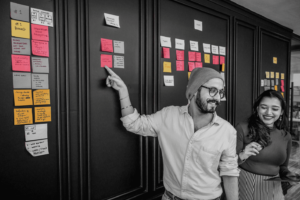Achieve Customer Centricity Through Design Thinking With SAFe® and Jira Align
SAFe® 5.0 is all about business agility. And, whether you adhere strictly to the SAFe® framework for scaled agile development or not, business agility should be a focus for your organization, too. It’s really the key to surviving and thriving in the rapidly changing business environment in which we all operate.
Two major components of overall business agility for software developers are customer centricity and design thinking. While they’re not new concepts, the SAFe® framework helps codify them more consistently than we’ve seen elsewhere. And, we believe Atlassian’s Jira Align offers the most robust and comprehensive tool available for incorporating both into your current and future development efforts. So, two of our internal subject matter experts — Tina Behers, Directory of Business Agility, and Jesse Pearlman, Business Agility Coach — dove deep into these subjects in a recent webinar.
Here, we’ll cover some of the key takeaways to whet your appetite to watch the free webinar recording at your next opportunity. We’re sure you’ll enjoy and benefit from the presentation.
What Is Customer Centricity and Why Does It Matter?
When you get down to it, customer centricity is really one of the original drivers behind Agile software development: placing the customer back where they belong, at the center of the development process. In practice, it means considering first the needs and desires of the customer or end-user when making decisions about what products to develop and when, what features to produce in which order, and so forth.
When done effectively, customer-centric planning and management can result in better products faster while reducing or eliminating costly missteps like developing a solution to a problem no one cares about.
Of course, claiming to care about what the customer thinks is one thing. Truly putting them at the center of the design and build process is a very different animal. It’s not simple, easy, or fast. It requires a tremendous amount of data and a commitment to continual refinement and adjustment as needed based on ongoing feedback.
Running your preconceived ideas through a couple of focus groups in an effort to establish support for what you’ve already decided to do is not a customer-centric strategy. Instead, a customer-centric organization would start the entire product ideation process with the basic questions, “what problem are we trying to solve, who has that problem, and what do they think or feel about a solution?” Ideation, design, development, marketing, sales, and customer support across the cradle-to-grave product lifecycle springs from the answers to those key customer-focused questions.
What Is Design Thinking and How Does It Facilitate Customer Centricity?
In this setting, design thinking refers to how developers design a product to take full advantage of the iterative nature of agile product management. It can be broken down into three overlapping phases of an ongoing product development cycle:
-
- Inspiration
- Ideation
- Implementation
The inspiration phase begins before anything is fleshed out, generally with the same basic questions outlined above:
- What problem are we solving and why?
- What solutions already exist and how good are they?
- Who cares and why?
- (Importantly) How do we identify a better solution and how do we test whether it’s actually better?
Ideation and implementation spring from the answers to those questions. Since design thinking begins from the questions of who and why rather than what and how, it really facilitates the placement of the customer at the center of the production process. And, with that final question leaving things open-ended, it supports the notion of iterative improvement based on feedback loops.
What Reports, Views, and Features Does Jira Align Offer to Support Customer Centricity and Design Thinking?
Implementing design thinking principles and achieving customer centricity in an agile enterprise requires complete alignment from the broadest of strategic components like mission, vision, and values to the individual stories each developer is working on day-to-day at the product development level. Obviously, this is a tremendous task, especially for large companies with multiple portfolios, products, and value streams, all of which should be focusing on different customers and use cases.
That’s where a tool like Jira Align becomes invaluable. It offers visibility into every aspect of development at every level of the enterprise, informing decision making from long-term strategic planning down to the day-to-day work-in-progress.
In short, Jira Align offers a single source of truth for everything an agile enterprise needs to plan, monitor, and optimize work in pursuit of business agility.
Stakeholders across the organization can access the system to drill down deep into individual work-in-progress stories, team allocations, budgets, and product backlogs. Or, they can zoom out to the 50,000 foot view to understand the company’s vision, mission, values, and overarching strategic drivers. In between, program managers, product managers, and product owners can record and continually refine information about their customer personas, competitors, and other market forces that impact development.
Here are just a few examples of reports and views available within Jira Align and the incredible value they can offer agile development organizations:
-
- Portfolio Canvas – Paints a broad picture of the portfolio and its parts, informing the product vision and the strategic roadmap. It offers a rough sense of budget, business scope, value streams, customers, strategic milestones, OKRs, and ROI.
-
- Business Model Canvas – Decomposes the Portfolio Canvas information into specific product understandings and outcomes. The focus here is on understanding who the customers are and what they want, as well as the competitive landscape around the product being developed.
-
- Product Canvas – Narrows down the customer pain points and what the customer hopes to gain from a solution. Relies heavily on fully-fleshed out personas and competitive information to ensure the customer remains at the center of design thinking.
-
- Program Coordination Journey – Maps out the customer’s interactions with the solution to inform development priority, scheduling, and other assumptions, then monitor actual results against predictions.
- Roadmaps – A schedule of events and milestones that communicate planned solutions deliverables over a planning horizon. They provide all stakeholders with a view of the current, near-term, and longer-term deliverables, even down to fine-grained story maps and product backlogs populating individual planning increments.
For more details on all these powerful tools and more, check out the full webinar, “How to Maximize Design Thinking and Customer Centricity With SAFe® and Jira Align.”




